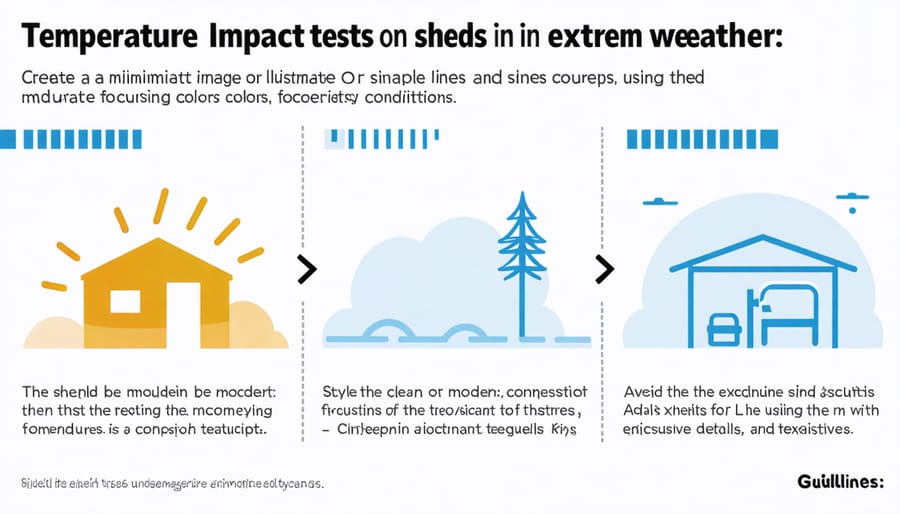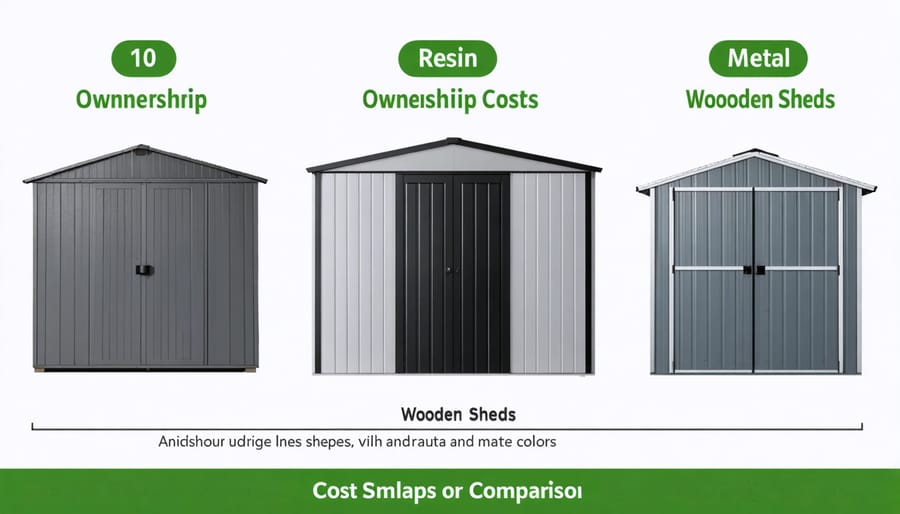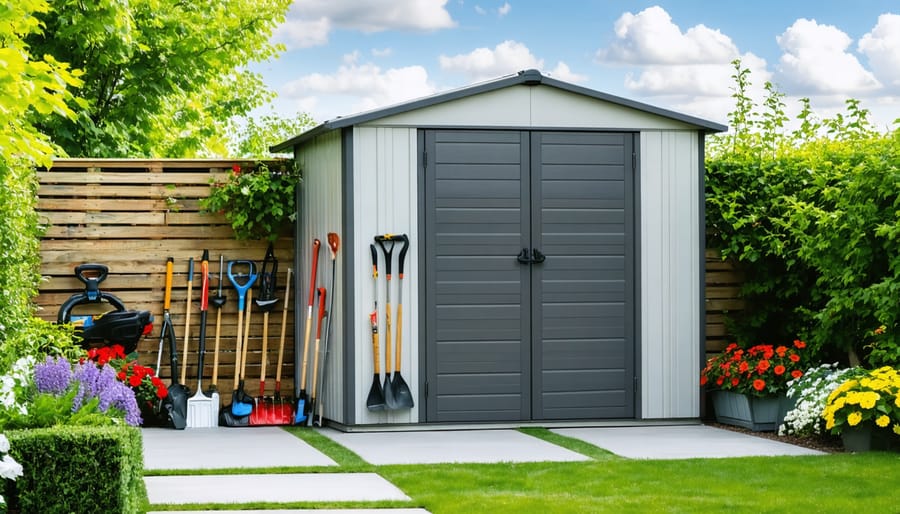Resin storage sheds have revolutionized backyard storage solutions, offering homeowners a perfect blend of durability and convenience without the maintenance headaches of traditional wooden structures. These modern marvels stand up remarkably well against harsh weather conditions, resist rust and rot, and maintain their appearance for years with minimal upkeep. While typically more expensive than basic metal alternatives, resin sheds deliver exceptional value through their superior weather resistance, UV protection, and sturdy construction that won’t dent like metal or deteriorate like wood. For homeowners seeking a long-term storage solution, resin sheds prove particularly compelling with their easy assembly, impressive strength-to-weight ratio, and ability to withstand everything from scorching summers to freezing winters. Whether you’re storing garden tools, outdoor furniture, or seasonal decorations, understanding the true capabilities and limitations of resin sheds can help you make an informed decision about this increasingly popular storage option.
The Real Benefits of Resin Storage Sheds
Weather Resistance and Durability
Resin storage sheds excel in their weather resistance capabilities, making them an excellent choice for various climates. Unlike traditional wooden sheds that can rot, warp, or require regular maintenance, resin sheds are specifically engineered to withstand nature’s elements. They’re completely waterproof, preventing rain and snow from seeping through, and won’t rust like metal alternatives.
These sheds handle UV exposure remarkably well, featuring special additives that prevent fading and deterioration from sun damage. During hot summers, resin sheds maintain their structural integrity without warping or buckling, while in winter, they resist cracking and becoming brittle. They’re also impervious to pest infestations and won’t suffer from termite damage or wood rot.
The durability of resin sheds extends beyond weather resistance – they don’t require painting, staining, or regular maintenance beyond occasional cleaning. Many homeowners report their resin sheds looking nearly new even after years of exposure to challenging weather conditions, making them a reliable, long-term storage solution.

Maintenance and Care Requirements
One of the biggest advantages of resin storage sheds is their minimal maintenance requirements. Unlike wooden sheds that need regular painting and sealing, resin sheds only require occasional cleaning with soap and water to maintain their appearance. A simple rinse with a garden hose can remove most dirt and debris, while stubborn stains can be tackled with a mild detergent solution and soft brush.
To keep your resin shed in top condition, perform these simple maintenance tasks:
– Check the roof periodically for leaf buildup and clear any debris
– Inspect door hinges annually and lubricate if needed
– Ensure proper drainage around the shed’s foundation
– Tighten any loose screws or fasteners once a year
– Clean the exterior walls seasonally to prevent mold or mildew
During winter months, removing snow from the roof is important to prevent excess weight buildup. The UV-resistant materials used in modern resin sheds help prevent fading and deterioration, but positioning your shed away from constant direct sunlight can extend its life even further.
Remember that while resin sheds are low-maintenance, they’re not completely maintenance-free. Regular checks and basic cleaning will help ensure your shed remains functional and attractive for many years to come.
Common Concerns About Resin Sheds
Temperature Sensitivity
Resin sheds demonstrate varying performance across different temperature ranges, making it essential to understand their thermal characteristics. In moderate climates, these sheds maintain their structural integrity exceptionally well. However, during extreme temperature conditions, you might notice some changes in their behavior.
In intense heat, resin sheds can become slightly more flexible, though modern manufacturing techniques have significantly improved their heat resistance. Most quality resin sheds can withstand temperatures up to 100°F (38°C) without significant issues. However, prolonged exposure to direct sunlight might cause minor fading over time, though this is primarily cosmetic and doesn’t affect functionality.
During cold weather, resin sheds become somewhat more rigid but maintain their structural integrity. Unlike metal sheds that can become brittle in freezing temperatures, resin sheds typically handle winter conditions well, with most models tested to withstand temperatures as low as -20°F (-29°C).
To maximize temperature resilience, consider these practical tips:
– Position your shed in a partially shaded area if possible
– Ensure proper ventilation to prevent heat buildup
– Use UV-protective sprays for additional sun protection
– Install a proper foundation to minimize ground temperature effects
– Consider adding insulation for extreme climate regions
While temperature fluctuations can affect resin sheds, their overall thermal performance remains reliable for most residential storage needs, especially when compared to traditional materials like metal or wood.

Long-term Stability
When properly maintained, resin storage sheds demonstrate impressive long-term stability that can span decades. The key to ensuring this longevity starts with proper foundation installation, which prevents structural issues down the line. Unlike wooden sheds that can rot, warp, or become susceptible to termites, resin sheds maintain their structural integrity remarkably well over time.
These sheds are engineered to withstand various weather conditions without degrading. The high-quality polyethylene used in modern resin sheds resists UV damage, preventing the material from becoming brittle or fading significantly. Many homeowners report their resin sheds looking nearly new even after 10-15 years of use.
The panels are designed to maintain their shape and rarely buckle or bend, provided they’re assembled correctly. The metal reinforcements integrated into premium resin sheds add extra stability, ensuring the structure remains square and true over the years. While the initial cost might be higher than some alternatives, the minimal maintenance requirements and long-lasting durability make resin sheds a cost-effective choice in the long run.
However, it’s worth noting that regular checks of the roof panels and door hinges, along with occasional cleaning, will help maximize your shed’s lifespan. Most manufacturers offer extensive warranties, often 10-15 years, demonstrating their confidence in the product’s long-term stability.
Real-World Performance
Customer Experiences
Many Duramax shed owners have shared positive experiences with their resin storage solutions. Sarah Thompson, a homeowner from Oregon, reports that her 8×6 resin shed has withstood three years of heavy rain and wind without any signs of rust or degradation. “It’s exactly what I needed for storing my gardening tools and outdoor furniture,” she says.
John Martinez, a DIY enthusiast from Florida, particularly appreciates the low maintenance aspects. “Unlike my old metal shed, this one doesn’t need painting or rust treatment. I just hose it down twice a year, and it looks good as new,” he shares.
However, some users note important considerations. Lisa Chen mentions that proper foundation preparation is crucial: “Once we got the base right, assembly was straightforward, but don’t skip the foundation step.” Other owners highlight the importance of following assembly instructions carefully to ensure optimal performance.
Most long-term users report satisfaction with their sheds’ durability and weather resistance. Common praise points include good ventilation, resistance to pests, and the ability to withstand extreme temperatures without warping or fading.
Value for Money
Resin storage sheds offer excellent value for money when compared to traditional materials like wood or metal. While the initial purchase price might be slightly higher than some metal alternatives, resin sheds typically require minimal maintenance, saving you money in the long run. Unlike wooden sheds that need regular painting, staining, and weather protection treatments, resin sheds maintain their appearance without these additional expenses.
A mid-sized resin shed typically costs between $500 to $1,500, depending on the brand and features. While a comparable wooden shed might cost $400 to $1,200 initially, factor in maintenance costs of approximately $100-200 annually for wood preservation, paint, and repairs. Metal sheds, though often cheaper upfront at $300-800, may require rust treatment and replacement parts over time.
The long-term durability of resin sheds also means you won’t need to replace them as frequently as other materials. Most quality resin sheds last 15-20 years with proper care, making them a cost-effective choice for homeowners seeking a reliable storage solution. When you consider the minimal upkeep requirements and extended lifespan, resin sheds prove to be a smart investment for your property.

Making the Right Choice
When it comes to choosing the right storage shed, resin models can be an excellent choice for many homeowners, but it’s essential to evaluate your specific needs and circumstances. Consider your climate first – resin sheds excel in areas with moderate weather conditions and perform particularly well in humid environments where metal might rust or wood could rot.
Think about your storage requirements and available space. Resin sheds are ideal if you’re planning to store garden tools, outdoor furniture, or seasonal items. They’re perfect for homeowners who want a low-maintenance solution and don’t plan to make frequent structural modifications to their shed.
Your budget plays a crucial role too. While resin sheds might cost more upfront than some metal options, their durability and minimal maintenance requirements often make them more cost-effective in the long run. They’re also a great choice if you’re looking for something you can assemble yourself without professional help.
Consider your aesthetic preferences as well. Modern resin sheds come in various styles and colors that can complement your home’s exterior. They’re particularly suitable for homeowners who want their storage solution to maintain its appearance with minimal effort.
However, if you need a highly customizable structure or plan to install many shelves and hanging systems, you might want to explore other options. Resin sheds work best when used as intended, with simple modifications and standard storage solutions.
The key is to match your specific needs with the inherent benefits of resin sheds – durability, weather resistance, and low maintenance – while being mindful of their limitations.
Resin storage sheds offer a practical, durable, and low-maintenance solution for homeowners seeking reliable outdoor storage. Their weather resistance, UV protection, and ease of assembly make them an excellent choice for most residential settings. While they may cost more initially than some alternatives, their long-term value, minimal upkeep requirements, and resistance to rot and rust justify the investment. For best results, ensure proper foundation preparation and regular cleaning to maintain their appearance and functionality. Based on their overall performance and user satisfaction, resin sheds are indeed a worthwhile investment for homeowners who prioritize durability and convenience. Just remember to choose a reputable manufacturer, follow installation instructions carefully, and consider your specific storage needs and local climate conditions when making your final decision.





Leave a Reply